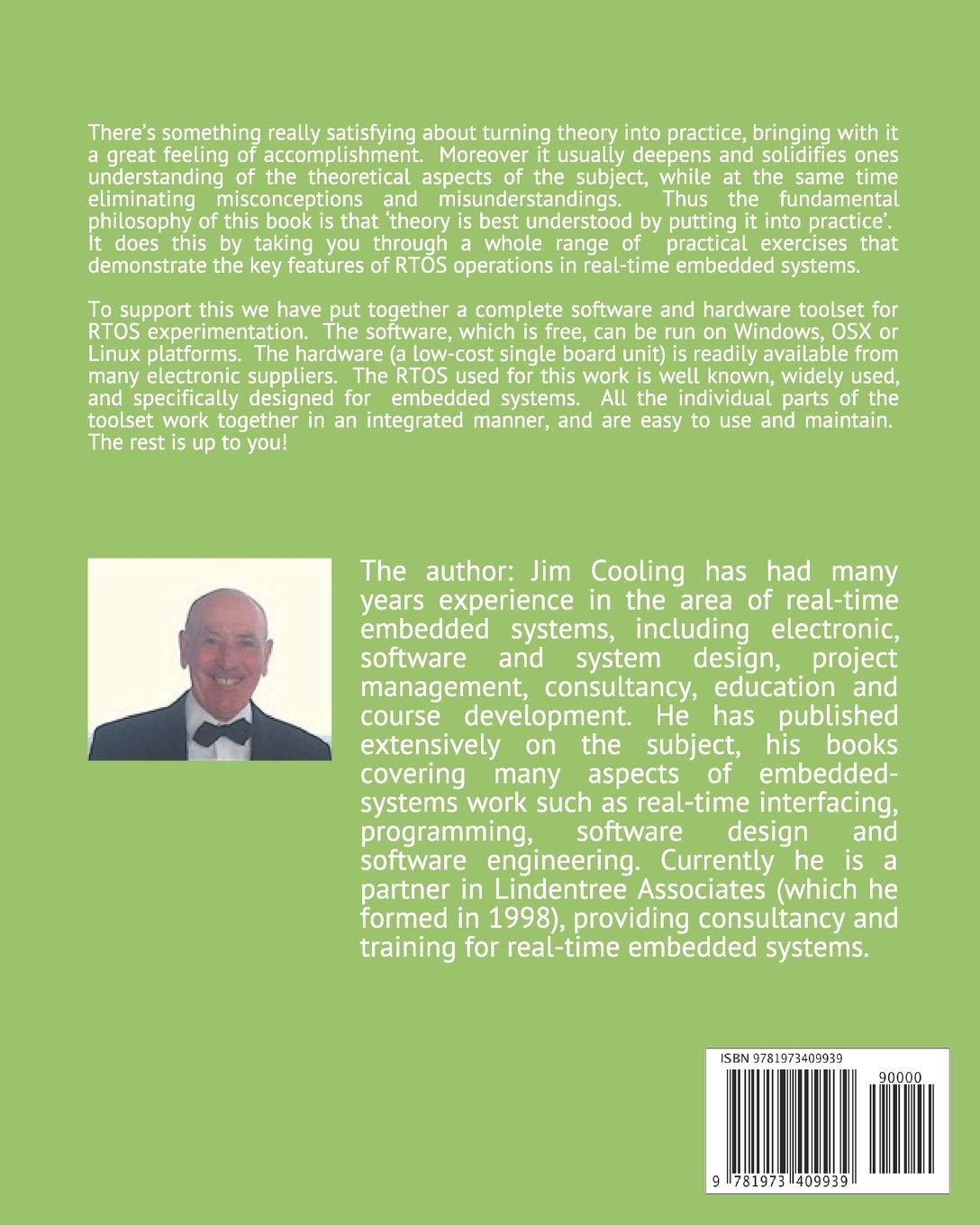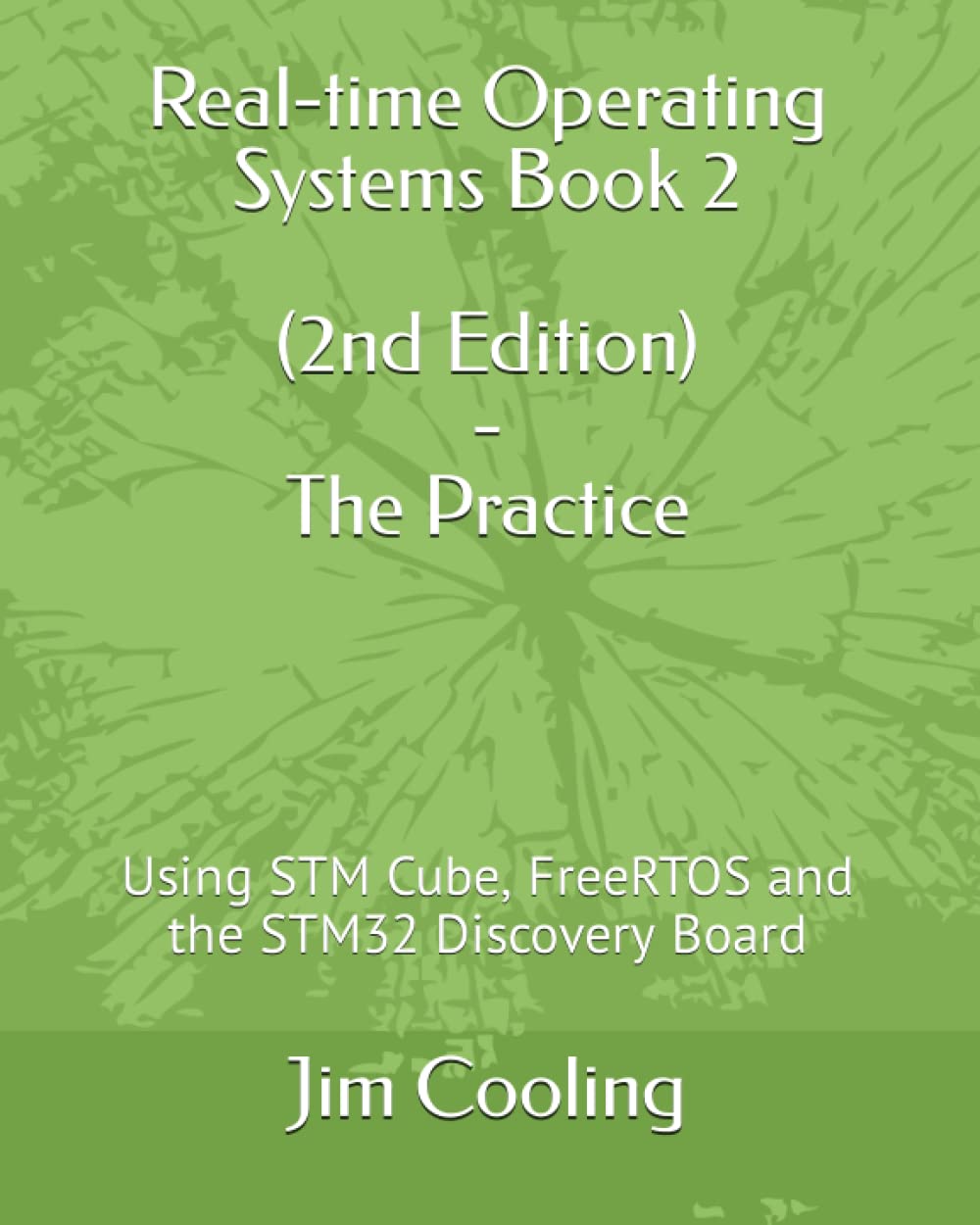Real-time Operating Systems Book 2 – The Practice: Using STM Cube, FreeRTOS and the STM32 Discovery Board (Engineering of Real-Time Embedded Systems)
$33.30

Price: $33.30
(as of Dec 27, 2024 01:14:21 UTC – Details)
There’s something really satisfying about turning theory into practice, bringing with it a great feeling of accomplishment. Moreover it usually deepens and solidifies your understanding of the theoretical aspects of the subject, while at the same time eliminating misconceptions and misunderstandings. So it’s not surprising that the the fundamental philosophy of this book is that ‘theory is best understood by putting it into practice’. Well, that’s fine as it stands. Unfortunately the practice may a bit more challenging, especially in the field of real-time operating systems. First, you need a sensible, practical toolset on which to carry out the work. Second, for many self-learners, cost is an issue; the tools mustn’t be expensive. Third, they mustn’t be difficult to get, use and maintain. So what we have here is our approach to providing you with a low cost toolset for RTOS experimentation.The toolset used for this work consists of:A graphical tool for configuring microcontrollers (specifically STM32F variants) – STM32CubeMX software application.An Integrated Development Environment for the production of machine code.A very low cost single board computer with inbuilt programmer and debuggerAll software, which is free, can be run on Windows, OSX or Linux platforms. The Discovery kit is readily available from many electronic suppliers. The RTOS used for this work is FreeRTOS, which is integrated with the CubeMX tool. Now for a word of caution and advice. If you want to learn about the fundamentals of Real-Time Operating Systems, this is not the book for you. For that you need to study the material contained in Book 1 (or an equivalent textbook). This book assumes that you are fully conversant with that level of theory.The author: Jim Cooling has had many years experience in the area of real-time embedded systems, including electronic, software and system design, project management, consultancy, education and course development. He has published extensively on the subject, his books covering many aspects of embedded-systems work such as real-time interfacing, programming, software design and software engineering. Currently he is a partner in Lindentree Associates (which he formed in 1998), providing consultancy and training for real-time embedded systems.See: www.lindentreeuk.co.uk
Publisher : Independently published (November 28, 2017)
Language : English
Paperback : 366 pages
ISBN-10 : 1973409933
ISBN-13 : 978-1973409939
Item Weight : 1.61 pounds
Dimensions : 8 x 0.83 x 10 inches
10 reviews for Real-time Operating Systems Book 2 – The Practice: Using STM Cube, FreeRTOS and the STM32 Discovery Board (Engineering of Real-Time Embedded Systems)
Add a review

$33.30







Yassine –
Good content: theory and practice!
Iâm a graduate student and I needed a quick review of Real-Time OS before starting to look for a job in embedded software engineering. Those two books did the trick. Itâs simplified but still relevant and they offer practice which is what I was aiming for.
Gary SSN –
Fast delivery
A practical guide to RTOS. The delivery is fast.
wiredweird –
Depends on what you want
The big strengths of this book are clarity and specificity. Using a specific model of evaluation board and specific RTOS, this guides the reader gently through a series of graded exercises. Each step demonstrates a particular OS feature in isolation. So, when the reader sits down to work on existing code, or to build a system from scratch, the reader will be able to see through incidentals and application-specifics to understand what’s going on with the underlying OS.As happens all too often, the book’s strengths could also be its weaknesses. Too much attention to a specific hardware and software set can lead to tunnel vision. There are dozens of processor cores out there with their own idiosyncrasies, not to mention the thousands of microcontrollers built around those cores. There are dozens of commercial, open-source, and home-grown embedded environments, in addition to bare metal, each with quirks and limitations of their own. Multi-core, heterogeneous, non-C languages, porting issues, support libraries – it’s a big world out there. If all you’ve seen is this book, you might not be well prepared for all the kinds of variation to expect.So, I come away with a decidedly mixed impression. Cooling offers gentle, detailed guidance to someone’s first few steps with an RTOS, and many readers with no access to other resources will appreciate that. But I don’t know how those readers will feel when the training wheels eventually come off and they’re thrown into a serious industrial project.– wiredweird
sean taylor –
Nothing wrong with the book, but Udemy course was better for similar money
The books is very thorough, but I found an Udemy course covering FreeRTOS on the STM32 using SW4STM32 IDE, and overall I feel the udemy approach was better for me for about the same money.
Ronald –
Muy didáctico
Contiene casos muy prácticos!
Dawid Kopys –
Ragged, misleading at some points, shallow.
To be honest, I dont even know where to begin.There is nothing more annoring than dealing with some problem for 2 hours straight, only to find out that the bug is found in the book itself. You will have plenty of situations like this during the ‘pleasure’ of studying from this book.The book lacks source code examples. In some places the author asks questions concerning the exercises. Some of them are left unanswered, which makes it impossible to verify your answers/assumptions.I am sure any reader would appreciate exercise solutions in some form. That would enable them to compare their solution with the author’s one. I believe I do not have to explain how useful such solutions can turn out to be. Unfortunately, the author doesnt provide anything like that (or at least I have not found it, correct me if I am wrong).Numerous substantive errors and understatements make it really hard to follow the exercises. It seems to me that without some previous experience you may fail to do so.Do not get me wrong. The book does contain SOME useful and interesting information, but man, it is so painful to get through the rest of the book in order to get to those few worthy paragraphs.Even the language in which the book is written leaves a lot to be desired, to say the least. However, this is lesser of a problem at the book continues – maybe because there are less mistakes, or maybe because you get used to it. I am well aware of the fact that this review isnt written in perfect english as well, but this is a review, not a book I want people to pay me for.As I said, although the book contains some worthy material, I would not recommend this as a first choice to anyone. It is just too irritating to go through the exercises. Even though there arent many books on the topic, I would still look for other sources.
Xavier R –
Don’t buy book 2. You might buy the Book 1 instead.The Book 1 is a wonderful book on operating systems. Book 2 is a shame, worst if you buy the Kindle edition.Book 2 focus on none operating system and all, at the same time. In a single chapter it uses the mbed OS, and later on it uses FreeRTOS. For newbies it’s a terrible experience.There is no repository for the examples. Github and Bitbucket are free! But seems the author is not aware of them.Every example includes the learning objectives, however such examples doesn’t have any learning value. You must read the Volume I in order to understand the examples. I consider myself as a ongoing expert in the topic, but I didn’t get the examples.It gets worst: the exercises. Every chapter includes hands on exercises. Good lock!
Amazon Customer –
Very good
Pablo T R. –
excelente libro, lo volverÃa a comprar, la parte uno no defrauda tampoco. Tal vez hay algunos problemas que se me presentaron en la practica con el configurador cube mx que no menciona.
Amazon Customer –
Needs the volume 1 really to understand the concepts.